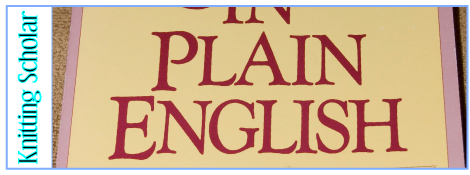First, the facts:
Title: Knitting in Plain English
Author: Maggie Righetti
Published by: St. Martin’s Press, 1986
Pages: 240
Type: How-to, Design.
Sections:
1. Before You Begin to Knit
2. Details, Details, Details
3. After the Last Stitch is Worked
4. Learning Lessons
Pattern Size Range: N/A
The In-Depth Look:
There are a couple things you need to know right away.
First is that this is the book that I learned to knit from, back in 1988, and Maggie Righetti seriously shaped the way I think of knitting. Which, in turn, is going to color this review because, well, how could it not?
Second, there is a newer, updated edition (circa 2007) … but my copy is the older edition, and so it’s the one I’m reviewing. I’ve flipped through the new version at the bookstore and can tell you that there are some pretty substantial changes, but many of the basics are unchanged. But the ratio of old to new? What, exactly, has been updated or not updated? I honestly don’t know–but because of the quality of the original, I’ve recommended this book many, many times and haven’t heard any complaints.
So, with those caveats out of the way …
Yes, I love this book. The cover of my copy says, “Full of easy-to-follow lessons and patterns and sensible solutions to nagging problems, it’s the only book any knitter will ever need.”
Now, clearly, I’ve bought any number of books since then. (In fact, I think my second knitting book was Elizabeth Zimmerman’s Knitting Around … did I start out with a pair o winners, or what?) Having read through this book several times, though, and using it as a reference, it has stood me well for years.
The tone of this book, first of all, is friendly and conversational. The kind of “how-to” you would get from the nice person at your local yarn shop at a private lesson. Pieces of advice about what to carry in your knitting bag, or the reasons you might want to learn Continental knitting as well as English knitting. Why you shouldn’t trust the models in pattern photos. How to hold your yarn. How to make increases and decreases, and why the slant matters.
Ultimately, this is a basic, how-to book. It teaches you how to knit, it does it well, it does it thoroughly and it has a good time along the way.
Drawbacks? Well, the illustrations are black and white. No glossy photos in this book, so it’s not the prettiest knitting book around. It’s also text-dense, so it’s thorough, but it takes a fair amount of reading. If you want a how-to book with really great pictures but that doesn’t require a lot of reading, this book is not for you. But between the graphics and the words, there isn’t any technique that I haven’t been able to figure out.
For that matter, I personally find this approach–good written descriptions backed up with clear pictures–the easiest way to learn. Too many other “beginner” knitting books give you a photo, a sentence or two, and maybe an arrow, if you’re lucky. I had tried to teach myself how to knit properly for years but the “Learn to Knit!” type booklets we picked up at K-mart were never helpful enough. But I also learn well by reading–it’s my preferred method of absorbing new knowledge, but not everyone’s brain works that way.
You also wouldn’t want to buy this book for the patterns. There are a couple in my copy, but with names like “The Dumb Baby Sweater” and “The Stupid Baby Bonnet,” you can imagine that they’re not really the main point of the book–the included patterns are there for learning experiences, not so much for a beautiful, knitted object.
Again, of course, mine is the old copy. The new edition may even have color photos, for all I know, and she may have added more or “better” patterns. But the important parts–the Teaching sections–are what really matters.
It was thanks to Maggie Righetti and this book that my very first real knitted project was a full-size, Lopi Icelandic sweater, knit in the round with two colors, one held in each hand, and completed in a total of 10-days. Miles away from the various, garter-stitch rectangular things I had made before I learned how to purl and do basic shaping.
It’s because of this book (and that sweater) that I’m hooked on knitting. And not only hooked, but also unafraid to try anything, because Maggie Righetti’s book inspires confidence and a sense of exploration and adventure.
It’s a 20-year old book, and times have changed … but, I beg you, don’t let its lack of hipness keep you from at least taking a look at this book. The current crop of learn-to-knit books (like Debbie Stoller’s Stitch and Bitch) are edgier, hipper, trendier. There’s nothing wrong with that or with them, but this book was miles ahead of the dry, textbook-like books I’d seen before. She has opinions, but she leaves you the right to make up your own mind.
After all, if it weren’t for this book, you wouldn’t be here reading knitting book reviews now, would you?
This book is available at Amazon.com (link is to the newer edition).
Want to see bigger pictures? Click here.

My Gush: How can I possibly be fair and unbiased about the book that single-handedly got me hooked on knitting? And yet, it’s all good….



Comments on this entry are closed.
How sad is it that I’ve had that book for years and haven’t cracked it open?! Bad me.
I LOVE that book! It’s an excellent resource. I learned using it myself, it was the closest thing I had to a teacher.
Carrie K´s last blog post..Ten Is A Lot
She really gives a lot of common sense and calming information. Her book, Sweater Design in Plain English, is great, too.
Suzann´s last blog post..Old Crochet Book at Comanche Museum